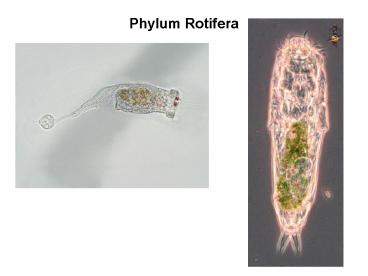Phylum Rotifera PowerPoint PPT Presentation
Title: Phylum Rotifera
1
Phylum Rotifera
2
Phylum Rotifera
Pseudocoelomate - coelom is remnant of blastocoel
and not completely surrounded by
mesoderm. Advantages of coeloms.
3
What do rotifers look like?
Jointed cuticle. Telescoping foot. Toes with
pedal glands for adhesion. Corona - cilia ring.
4
How do rotifers support themselves and move?
Cuticle provides support. Pseudocoelom acts as a
hydrostatic skeleton to protrude body parts (foot
and trochal discs of corona).
5
How do rotifers support themselves and move?
Many swim using coronal cilia.
6
How do rotifers support themselves and move?
Many creep by attaching foot and elongating body
to extend forward. Bands of muscles.
7
How do rotifers support themselves and move?
Cerebral ganglia and longitudinal nerve cords.
Corona has tactile bristles, chemoreceptors, one
ocellus, and antennae.
8
How do rotifers feed themselves?
Variety of feeding methods.
9
How do rotifers feed themselves?
Complete digestive system. Salivary glands and
gastric glands. Mouth, stomach, intestine, anus.
10
How do rotifers circulate nutrients and
osmoregulate?
Pseudocoelom acts as medium for circulation. Size
aids in diffusion of gas and nutrients. Protonephr
idia with flame bulbs. Nephridioduct leads to
bladder which empties in cloaca.
11
How do rotifers reproduce?
Males with simple testis sperm duct and
gonopore. Females produce eggs in ovary and yolk
is added before moving to oviduct and
cloaca. Internal fertilization. Eggs are
encapsulated and deposited on substratum.
12
How do rotifers reproduce?
Asexual reproduction by parthenogenesis
alternates with sexual reproduction. Females
mitotically produce diploid ova (amictic ova)
which develop without fertilization into females.
13
How do rotifers reproduce?
With proper stimulus, some females meiotically
produce haploid eggs (mictic ova) which develop
parthenogenetically into haploid males which
produce sperm by mitosis. These sperm fertilize
mictic ova and produce thick-walled zygotes to
survive extreme conditions. Zygotes hatch into
amictic females when conditions good.
PowerShow.com is a leading presentation sharing website. It has millions of presentations already uploaded and available with 1,000s more being uploaded by its users every day. Whatever your area of interest, here you’ll be able to find and view presentations you’ll love and possibly download. And, best of all, it is completely free and easy to use.
You might even have a presentation you’d like to share with others. If so, just upload it to PowerShow.com. We’ll convert it to an HTML5 slideshow that includes all the media types you’ve already added: audio, video, music, pictures, animations and transition effects. Then you can share it with your target audience as well as PowerShow.com’s millions of monthly visitors. And, again, it’s all free.
About the Developers
PowerShow.com is brought to you by CrystalGraphics, the award-winning developer and market-leading publisher of rich-media enhancement products for presentations. Our product offerings include millions of PowerPoint templates, diagrams, animated 3D characters and more.

